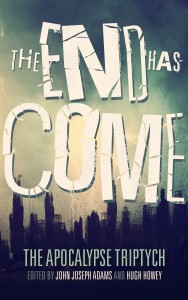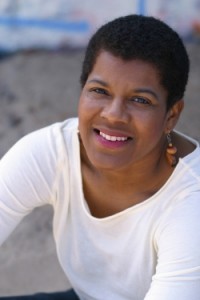
Buy The End Has Come, edited by John Joseph Adams and Hugh Howey
In collaboration with editors John Joseph Adams and Hugh Howey, A Dribble of Ink is proud to introduce a series of interviews with the authors of The End Has Come, the final volume in the The Apocalypse Triptych. Following on The End is Nigh, and The End Is Here, The End Has Come contains 23 stories about life after the apocalypse.
Interview with Tananarive Due about “Carriers”
(Interview by Jude Griffin)
I was very excited to see another story in this world with Nayima—how has the character changed since you first began writing her?
In the first story, Nayima was a young woman forced to come of age against the backdrop of a super plague. That story was really me processing the true end of my own childhood, with the long suffering and death of my mother. But at least Nayima had a sense of moving on to the next phase of her life. In the second story, Nayima was shattered. I believe she was forced to give up her last notions of communal humanity–she herself was toxic, and her dreams of building a village were silly and, in a way, even selfish because of her deep denial that she was a carrier. So the Nayima of “Carriers” is a hardened, solitary woman who had given up hope of a “normal” life. And she has lost her trust in everyone.
I found the night cats fascinating—how did they come about?
Ah, the night cats! I have always had cats, but the age of YouTube is turning me into a bit of a cat fanatic. I can watch funny cat videos for days. One day I was research more exotic breeds of cats like Savannahs and I came across an article about the plague of feral cats in Australia, where there are actually bird species being wiped out and endangered in areas where cats have taken over. Cats are excellent hunters with few natural predators.
I decided to bring the feral cats into this story because I wanted to explore the changes in the ecological system since the plague. If mankind were virtually eliminated, how might that look? I didn’t say so in the final draft, but dogs died in the plague and cats didn’t. So now Nayima has been reduced to a kind of primal state, fighting for resources with wild animals whose immediate ancestors were docile house pets. As a cat lady, that idea intrigued me—and also the question of what it means to be “domesticated,” since Nayima has welcomed two of the cats—but ONLY two—into her home. I see her adoption of the two cats as an attempt to reclaim the part of her that can love another, which was damaged so deeply by the events in the first two stories.
The difference between Raul and Nayima is so stark: one embraces hope, the other rejects it. Are there other choices for people living under such difficult circumstances?
I think all survivors of a mass extinction would fall somewhere within the spectrum of hope and depair. Nayima may seem to have lost hope, but she is building a home even after her first was stolen from her, she has not killed herself, and she has managed to cling to her sanity. I think that’s pretty amazing. Raul’s naiveté might have been laughable under earlier circumstances, but after a period of collective madness, society IS shifting back toward a sense of justice. They have lived long enough–as many of us will–to see great social changes in their lifetimes. The goverment may well only want to study them, but Nayima and Raul been given an opportunity to live fuller lives–the life Nayima dreamed of in “Herd Immunity.”
As the child of civil rights activists and a social justice activist myself, I also want to impart to the activist community that there IS hope despite setbacks. There will always be people who agitate and advocate for change.
Nayima’s decision to open the door at the end, her emotional state once she sees her daughter, was unexpected but wonderful. Please tell me there is more after this.
In one sense, Nayima was simply tired of fighting. She realized that if she couldn’t bring herself to shoot a cat, she certainly wasn’t going to fight marshals and potentially see Raul hurt or killed. But Nayima was also trying to follow Raul’s example and embrace hope. Yes, she is putting her heart in grave danger if she attaches to a child she has no power to keep, ultimately–it could be a tremendously manipulative act on the part of the government–but she is willing to take that chance for the promise of love and family. Humans need other humans.
Any projects/news you want to tell us about?
My first short story collection, Ghost Summer, will be published by Prime Books in October. I’m very excited about that! I have been publishing short stories since 2000, but this is the first collection of my major short works. And all three Nayima stories will be included.

About Tananarive Due
Tananarive Due is the Cosby Chair in the Humanities at Spelman College. She also teaches in the creative writing MFA program at Antioch University Los Angeles. The American Book Award winner and NAACP Image Award recipient has authored and/or co-authored twelve novels and a civil rights memoir. In 2013, she received a Lifetime Achievement Award in the Fine Arts from the Congressional Black Caucus Foundation. In 2010, she was inducted into the Medill School of Journalism’s Hall of Achievement at Northwestern University. She has also taught at the Geneva Writers Conference, the Clarion Science Fiction & Fantasy Writers’ Workshop, and Voices of Our Nations Art Foundation (VONA). Due’s supernatural thriller The Living Blood won a 2002 American Book Award. Her novella “Ghost Summer,” published in the 2008 anthology The Ancestors, received the 2008 Kindred Award from the Carl Brandon Society, and her short fiction has appeared in best-of-the-year anthologies of science fiction and fantasy. Due is a leading voice in black speculative fiction.
About the anthology
Famine. Death. War. Pestilence. These are the harbingers of the biblical apocalypse, of the End of the World. In science fiction, the end is triggered by less figurative means: nuclear holocaust, biological warfare/pandemic, ecological disaster, or cosmological cataclysm.
But before any catastrophe, there are people who see it coming. During, there are heroes who fight against it. And after, there are the survivors who persevere and try to rebuild.
Edited by acclaimed anthologist John Joseph Adams and bestselling author Hugh Howey, The Apocalypse Triptych is a series of three anthologies of apocalyptic fiction. The End Is Nigh focuses on life before the apocalypse. The End is Now turns its attention to life during the apocalypse. And The End Has Come focuses on life after the apocalypse.
Buy the book
The End Has Come is available as a trade paperback or eBook.

[…] Interview: Tananarive Due, posted by A Dribble of Ink […]